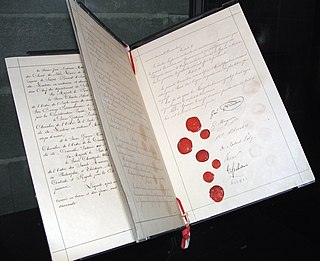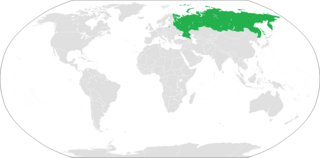
The Antarctic Treaty and related agreements, collectively known as the Antarctic Treaty System (ATS), regulate international relations with respect to Antarctica, Earth's only continent without a native human population. It was the first arms control agreement established during the Cold War, designating the continent as a scientific preserve, establishing freedom of scientific investigation, and banning military activity; for the purposes of the treaty system, Antarctica is defined as all the land and ice shelves south of 60°S latitude. Since September 2004, the Antarctic Treaty Secretariat, which implements the treaty system, is headquartered in Buenos Aires, Argentina.

Environmental laws are laws that protect the environment. Environmental law is the collection of laws, regulations, agreements and common law that governs how humans interact with their environment. This includes environmental regulations; laws governing management of natural resources, such as forests, minerals, or fisheries; and related topics such as environmental impact assessments. Environmental law is seen as the body of laws concerned with the protection of living things from the harm that human activity may immediately or eventually cause to them or their species, either directly or to the media and the habits on which they depend.

The Montreal Protocol is an international treaty designed to protect the ozone layer by phasing out the production of numerous substances that are responsible for ozone depletion. It was agreed on 16 September 1987, and entered into force on 1 January 1989. Since then, it has undergone nine revisions, in 1990 (London), 1991 (Nairobi), 1992 (Copenhagen), 1993 (Bangkok), 1995 (Vienna), 1997 (Montreal), 1998 (Australia), 1999 (Beijing) and 2016 (Kigali) As a result of the international agreement, the ozone hole in Antarctica is slowly recovering. Climate projections indicate that the ozone layer will return to 1980 levels between 2040 and 2066. Due to its widespread adoption and implementation, it has been hailed as an example of successful international co-operation. Former UN Secretary-General Kofi Annan stated that "perhaps the single most successful international agreement to date has been the Montreal Protocol". In comparison, effective burden-sharing and solution proposals mitigating regional conflicts of interest have been among the success factors for the ozone depletion challenge, where global regulation based on the Kyoto Protocol has failed to do so. In this case of the ozone depletion challenge, there was global regulation already being installed before a scientific consensus was established. Also, overall public opinion was convinced of possible imminent risks.
The Protocol on Environmental Protection to the Antarctic Treaty, also known as the Madrid Protocol, is a complementary legal instrument to the Antarctic Treaty signed in Madrid on October 4, 1991. It entered into force on January 14, 1998.

The United Nations Convention on the Law of the Sea (UNCLOS), also called the Law of the Sea Convention or the Law of the Sea Treaty, is an international agreement that establishes a legal framework for all marine and maritime activities. As of May 2023, 168 countries and the European Union are parties.

The law of war is the component of international law that regulates the conditions for initiating war and the conduct of hostilities. Laws of war define sovereignty and nationhood, states and territories, occupation, and other critical terms of law.

The Australian Antarctic Territory (AAT) is a part of East Antarctica claimed by Australia as an external territory. It is administered by the Australian Antarctic Division, an agency of the federal Department of Climate Change, Energy, the Environment and Water. The territory's history dates to a claim on Enderby Land made by the United Kingdom in 1841, which was subsequently expanded and eventually transferred to Australia in 1933. It is the largest territory of Antarctica claimed by any nation by area. In 1961, the Antarctic Treaty came into force. Article 4 deals with territorial claims, and although it does not renounce or diminish any pre-existing claims to sovereignty, it also does not prejudice the position of Contracting Parties in their recognition or non-recognition of territorial sovereignty. As a result, only four other countries — New Zealand, the United Kingdom, France, and Norway — recognise Australia's claim to sovereignty in Antarctica.

The Agreed Measures for the Conservation of Antarctic Fauna and Flora is a set of environmental protection measures which were accepted at the third Antarctic Treaty Consultative Meeting in Brussels in 1964. The Agreed Measures were formally in force as part of the Antarctic Treaty System from 1982 to 2011, when they were withdrawn as the principles were now entirely superseded by later agreements such as the 1991 Protocol on Environmental Protection to the Antarctic Treaty. The Agreed Measures were adopted in order to further international collaboration within the administration of the Antarctic Treaty System and promote the protection of natural Antarctic ecological systems while enabling scientific study and exploration.
The Agreement Governing the Activities of States on the Moon and Other Celestial Bodies, better known as the Moon Treaty or Moon Agreement, is a multilateral treaty that turns jurisdiction of all celestial bodies over to the participant countries. Thus, all activities would conform to international law, including the United Nations Charter.

Asteroid mining is the hypothetical extraction of materials from asteroids and other minor planets, including near-Earth objects.
Global commons is a term typically used to describe international, supranational, and global resource domains in which common-pool resources are found. Global commons include the earth's shared natural resources, such as the high oceans, the atmosphere and outer space and the Antarctic in particular. Cyberspace may also meet the definition of a global commons.

War can heavily damage the environment, and warring countries often place operational requirements ahead of environmental concerns for the duration of the war. Some international law is designed to limit this environmental harm.

The politics of outer space includes space treaties, law in space, international cooperation and conflict in space exploration, international economics, and the hypothetical political impact of any contact with extraterrestrial intelligence.

The environment of Russia
To protect the environment from the adverse effects of pollution, many nations worldwide have enacted legislation to regulate various types of pollution as well as to mitigate the adverse effects of pollution. At the local level, regulation usually is supervised by environmental agencies or the broader public health system. Different jurisdictions often have different levels regulation and policy choices about pollution. Historically, polluters will lobby governments in less economically developed areas or countries to maintain lax regulation in order to protect industrialisation at the cost of human and environmental health.

Tourism started in Antarctica by the sea in the 1960s. Air overflights started in the 1970s with sightseeing flights by airliners from Australia and New Zealand, and were resumed in the 1990s. The (summer) tour season lasts from November to March. Most of the estimated 14,762 visitors to Antarctica from 1999–2000 were on sea cruises. During the 2009 to 2010 tourist season, over 37,000 people visited Antarctica.

The Treaties of the European Union are a set of international treaties between the European Union (EU) member states which sets out the EU's constitutional basis. They establish the various EU institutions together with their remit, procedures and objectives. The EU can only act within the competences granted to it through these treaties and amendment to the treaties requires the agreement and ratification of every single signatory.

Christopher David Beeby was a New Zealand diplomat who held several ambassadorships and was involved in international litigation and negotiations, notably over Antarctic resources. Beeby was New Zealand's ambassador to Iran and to France and was a member of the World Trade Organization's Appellate Body from 1995 to his death in 2000. While ambassador to Iran, Beeby assisted American diplomats in the Iran hostage crisis.












